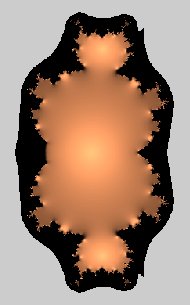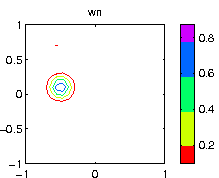so what is the rest of it?
(,
Sun 3 May 2009, 3:30,
archived)
Shitty explanation, but that's the sort of the idea. Number of steps it took to go away into infinity.
There are other features and methods to catalog a point; orbits, wells, and the like. I only get
or understand about 70% of what is actually going on with those kind of fractals.
(,
Sun 3 May 2009, 3:37,
archived)
There are other features and methods to catalog a point; orbits, wells, and the like. I only get
or understand about 70% of what is actually going on with those kind of fractals.
I just change the numbers slightly in the formulas until the child in me shouts 'pretty!!'
(,
Sun 3 May 2009, 3:40,
archived)
(, Sun 3 May 2009, 3:43, archived)
the others might be f(z)= z^3+c2 etc...
(,
Sun 3 May 2009, 3:52,
archived)
mandel
z(0) = c = pixel;
z(n+1) = z(n)^2 + c.
Two parameters: real & imaginary perturbations of z(0)
...and all I did was change the 'real' from 0 to 1, then 2, then 3...
(,
Sun 3 May 2009, 3:59,
archived)
z(0) = c = pixel;
z(n+1) = z(n)^2 + c.
Two parameters: real & imaginary perturbations of z(0)
...and all I did was change the 'real' from 0 to 1, then 2, then 3...
to piss off to infinity? I think I understand what's happening now...
This sortof thing is what happens when you fiddle with the power of z:

( that's f(z)=z^pi+c )
(,
Sun 3 May 2009, 4:09,
archived)
This sortof thing is what happens when you fiddle with the power of z:

( that's f(z)=z^pi+c )
Z takes a dim view on such behaviours.
(,
Sun 3 May 2009, 4:16,
archived)

It's generated by the equation governing a mexican who needs to shit
long explanation: it makes all kinds of wiggly patterns using sums
(,
Sun 3 May 2009, 3:41,
archived)
I kinda know a little bit about the generation of the fractal, but I don't understand what's going on with the map after the main features of the Mandelbrot set are apparent
(,
Sun 3 May 2009, 3:43,
archived)
...is infinite. All the other settings don't exhibit this. Although
Julia sets of near-by settings may do so. There may actually be
a real limit to the interior, as topographically there must be.
As to how far down the calculation that limit is--has been the
hard bit for the real math wanks. It's sort of like a mobius
strip in 2(plus some fraction)D. Or so Mandelbrot says.
edit: Not what you were on asking, as I see above, oops. [/;-)
(,
Sun 3 May 2009, 3:58,
archived)
Julia sets of near-by settings may do so. There may actually be
a real limit to the interior, as topographically there must be.
As to how far down the calculation that limit is--has been the
hard bit for the real math wanks. It's sort of like a mobius
strip in 2(plus some fraction)D. Or so Mandelbrot says.
edit: Not what you were on asking, as I see above, oops. [/;-)
I like the idea of 'I wanked the numbers in the iteration formula until i got something pretty'
(,
Sun 3 May 2009, 4:04,
archived)
we'd likely find that the set does resolve to continuous flat result between
any given feature points*. At least, that is what should happen. But that's
where my head starts to hurt. Mainly in how one can anticipate this from
the stated formula. Madness in jars and buckets if you ask me.
* except at the Mandelbrot set point.
(,
Sun 3 May 2009, 4:14,
archived)
any given feature points*. At least, that is what should happen. But that's
where my head starts to hurt. Mainly in how one can anticipate this from
the stated formula. Madness in jars and buckets if you ask me.
* except at the Mandelbrot set point.
Also
one should be careful to note that it is infinite within
the bounds that have been set to check or test for.
The rest, other colours, already went to infinity.
(,
Sun 3 May 2009, 5:26,
archived)
one should be careful to note that it is infinite within
the bounds that have been set to check or test for.
The rest, other colours, already went to infinity.


